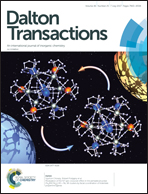Modulation of the FeII spin crossover effect in the pentadecanuclear {Fe9[M(CN)8]6} (M = Re, W) clusters by facial coordination of tridentate polyamine ligands†
Abstract
Spin crossover (SCO) materials, revealing the externally tunable transition between two different spin states, arouse great scientific interest due to their perspective application in information storage, display devices and sensing. Of special importance are the molecular systems offering the possibility of multimodal switching within many spin centers. This is achievable in polynuclear clusters consisting of several SCO-active complexes, however, such molecules are very rare. Herein, we report a unique pair of nanometric pentadecanuclear {Fe9[M(CN)8]6(Me3tacn)8}·14MeOH (Me3tacn = 1,4,7-trimethyl-1,4,7-triazacyclononane, M = Re, 1; M = W, 2) clusters exhibiting a thermally induced spin crossover effect on Fe(II) complexes, that is on both central and external Fe sites embedded in the cyanido-bridged cluster core. The spin transition occurs gradually in the 120–300 K range, and it is not fully completed even at room temperature. We show that facial coordination of an N,N,N-tridentate Me3tacn ligand dramatically modifies the character of the spin transition phenomenon when confronted with the previously reported {Fe9[M(CN)8]6(MeOH)24}·nMeOH (M = Re, W) clusters by (i) engaging, for the first time, not only central but also external Fe intracluster units in the SCO effect, (ii) cancelling the Fe–W charge transfer pathway, and (iii) decreasing the cooperativity within the supramolecular network.
![Graphical abstract: Modulation of the FeII spin crossover effect in the pentadecanuclear {Fe9[M(CN)8]6} (M = Re, W) clusters by facial coordination of tridentate polyamine ligands](/en/Image/Get?imageInfo.ImageType=GA&imageInfo.ImageIdentifier.ManuscriptID=C7DT01416C&imageInfo.ImageIdentifier.Year=2017)


 Please wait while we load your content...
Please wait while we load your content...